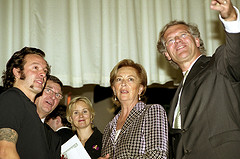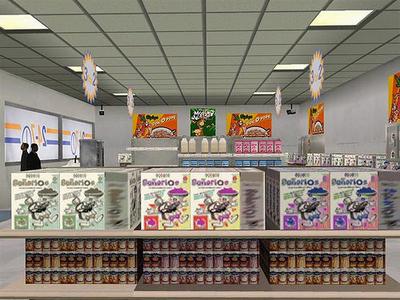Wow. The sale of one of the paintings I wrote about in the NYT the other day, a blue-period Picasso portrait being sold by Andrew Lloyd Webber,was recently ordered stopped by a Manhattan court. An heir to Paul von Mendelssohn-Bartholdy, who was forced to sell the painting in 1934, filed the suit.
Update: Thanks, Google News. Actually, according to the NYT’s report, the judge refused to block the sale. The Times also mentions the absence of any efforts by the heirs over the last 70 years to pursue a restitution claim, which is why I was surprised in the first place. Go about your business, nothing to see here.
Update update: Or maybe the sale won’t be blocked, just withdrawn. The Art Newspaper’s reporting that Christie’s may hold off on the sale tonight. Good thing that painting’s on one of them Lazy Susan deals.
Picasso Sale Blocked Over Nazi Claims [playfuls.com]
Or Not: Judge Refuses to Halt Auction of a Picasso [nyt]
Christie’s may withdraw Lloyd Webber’s Blue Period Picasso from sale [theartnewspaper.com, thanks marc]
Does Spelling Count?

Speaking of the 80’s, that was the last time I remember cracking open a copy of Interview Magazine. Judging from the excruciatingly tired art and pop culture names peppering this quiz given to prospective Interview employees, I guess I haven’t missed anything.
Plus, they spelled Philip Taafe, Polly Mellen, Sofia Coppola, and Steven Hawkin wrong.
Interview Pop Culture Test [tsg via gawker]
Gears For Fears
Jason posted a link to a preview for the video game Gears of War that uses Gary Jules’ and Michael Andrews’ acoustic cover of Tears for Fears’ “Mad World” as the soundtrack.
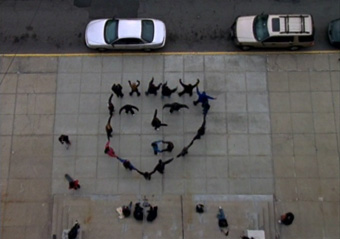
The original music video for Jules’ version is a favorite of mine. Even though the cult of Michel Gondry really bugs, I’m mostly a fan, and I’m a sucker for a well-done tracking shot, especially an outdoor one that can’t involve hundreds of takes because it relies on daylight.
That, and T4F allows me to relive my early teen mopiness and recall those days when my biggest dilemma was not living in London or LA.
Background on the Gondry video; a 2004 Chris Norris review of the video for the NYT. The Gondry video is on the Director’s Cut DVD for Donnie Darko, which restores some of the music from the Sundance version of the film.
My New Bidding Technique Is Unstoppable
That was my original choice for a title, but I’m happy enough just not botching the Hamlet reference. Thanks to all the people who helped with interviews and research and editing.
Since the story closed, I’ve heard from a couple of people who saw the Dora Maar sale, and it was even more incredible than I thought. Apparently, the guy bidding just kept waving his paddle all the way through the sale, even while he had the bid and was waiting for a competitor to respond. It’s as if he wasn’t following the proceedings at all, just waving the paddle until Tobias Meyer told him he’d won.
Rule No. 1: Don’t Yell, “My Kid Could Do That” [nyt]
Ersatz Serra/Smithson 2-Man Show In Front Of The House
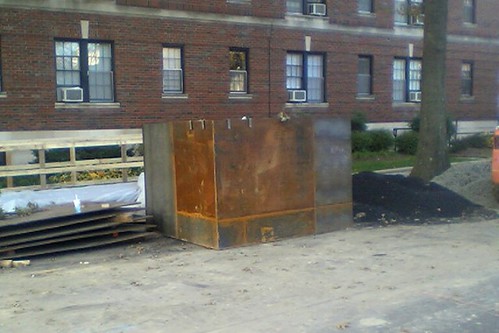
They’re doing construction in DC, and the workers dumped a found-art version of a Richard Serra/Robert Smithson installation in front of our house.
Nice Article On The Anime/Otaku Business Model
Dan Roth wrote a sweet article on AD Vision, the American anime distribution and production powerhouse, for Fortune last year. I just stumbled across the version of it on his blog.
One great example of their approach: bringing fans into the creative process, and very early to boot:
The flip side is also true: The fans can help wreck a show if they don’t like what they’re seeing. With that in mind, Ledford makes a point of keeping his fans in the loop. Since 2003 he’s been shopping the idea of making a live-action version of Neon Genesis Evangelion, the same show that spurred Ledford’s stalker–it is to otaku what Star Trek is to Trekkies. Ledford signed on the Weta Companies, the New Zealand special-effects firm behind the Lord of the Rings trilogy and the new King Kong, to come up with plans for what the Evangelion world might look like. But instead of micromanaging the project, Ledford had Weta answer to two Evangelion fanatics at his company.
Richard Taylor, Weta’s co-founder, says he’s never experienced anything quite like it. Twice a week he’d have a conference call with the fans at ADV, sending them renderings of his designs for things like the 100-foot-tall robots and getting in return their encyclopedic take on the interpretations. “These are people who could be considered scholars on the world of Evangelion,” says Taylor. “We had to appease them and find their approval.”
I’m thinking he may not have written the title, though:
Anime: It’s….Profitmon! [danielroth.net]
What Requiems For A Dream May Come
It feels like ages since I’ve posted about actual moviemaking around here. I was a fan of Darren Aronofsky’s Pi, and a fleeing refugee from the theater of Requiem for a Dream, but I have to give props to his vision and instinct for making his new film, The Fountain:
No matter how good CGI looks at first, it dates quickly. But 2001 really holds up. So I set the ridiculous goal of making a film that would reinvent space without using CGI.
…
Aronofsky and his crew flew to Central America to consult with legendary Mayan experts like Moises Morales Marquez, who has guided scholars through the ruins of Palenque for half a century. They made a pilgrimage to the Guatemala location used by George Lucas for the rebel-base scene in the original Star Wars film, high in the crumbling temples of Tikal.
…
The microzoom optical bench furnished Aronofsky’s film with something neither a computer nor an old-fashioned matte painter could deliver – chaos, in all its ultra high-definition fractal glory. “The CGI guys have ultimate control over everything they do,” Parks says. “They can repeat shots over and over and get everything to end up exactly where they want it. But they’re forever seeking the ability to randomize, so that they’re not limited by their imaginations. I’m incapable of faithfully repeating anything, but I can go on producing chaos until the cows come home.”
Palenque?
Steve Silberman interviewed Aronofsky for Wired [wired via bb]
The Relentless Pursuit Of Something, Anyway

Damn, I just hate when that happens. I hate when some sick poseur geezer company who makes SUV’s for orthodontists or whatever totally rips off and corrupts the free, utopian, non-commercial, creative spirit of youth–of the future, even. As if cool were simply something you could buy, or order up by the square foot. As if you could capture the real spirit and meaning of a place like Burning Man in a Beverly Hills storefront. That’s not what it’s all about, man. We go to the playa to get AWAY from our parents’ Lexuses.
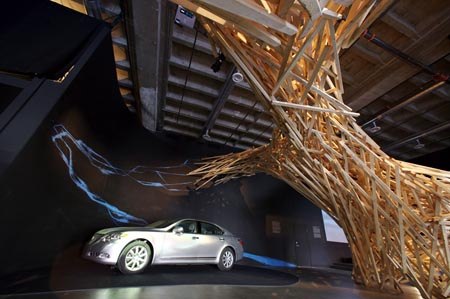
Look what Lexus has done, shamelessly copying the indescribable, ephemeral beauty and power of the Uchronia Project, and turning it into the backdrop for the launch of their new flagship model, the LS 460 sedan.
Forget the ethics of such a blatant act; I want to know logistics. How did Lexus’s agency even have mobilize in time to steal the work of a such a globally visionary and idealistic artist when it only landed at Black Rock City a few weeks ago? It’s as if–what’s that, you say? It’s the same guy?
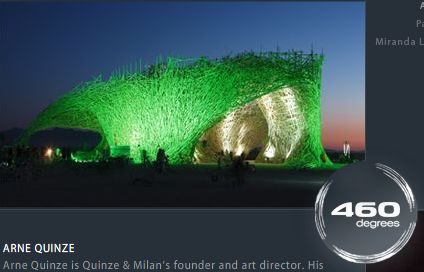
Well. Hate the playa, not the fame, I guess.
Lexus 460 Degrees Gallery [lexus.com via tropolism]Previous
Uchronyism on greg.org:
9/04: to think, there was a day–just one, but still–when it was just about the architecture
9/13: Uchronian partisans and Burning Man roast me for criticizing the Uchronspolitation
9/16:Branding Man [speaks for itself]
10/15: The King of Uchronia meets the Queen of Belgium
Update: There’s a debate raging among burners on tribe.net over whether artist burners should be taking money from corporate sponsors for their work. The answer is obvious: yes, if they want to, but it’s also irrelevant here. The Uchronia project was completely self-funded at BM [i.e., they didn’t get any art grants from BM itself like other projects], and its workers were paid, not volunteers.
What I suspected at the time has, I believe, been proved true now: Uchronia was built as part of an extensive marketing and promotional campaign which used Burning Man as a backdrop and platform to be leveraged externally after the fact. I originally thought it was just a self-promotion scheme for Arne Quinze and his firm, but I think the fully realized Uchronian Lexus Gallery appearing just weeks after BM shows who the real client was.
More evidence: one of the many burners who emailed me a month ago defending the Uchronians shared some of Quinze’s own explanations of his artistic bona fides, “[He said] he’s been selected to be the artist of the year at the upcoming Basel-Miami Art Fair.” Now I may not know Black Rock City, but I do know Basel, and Basel-Miami, and let me tell you, every single attendee there thinks he is “____ of the year.”
But according to Lexus’s gallery touring schedule, their 2-wk/city tour puts them in Miami right around the opening of ABMB. And while he was at BM, Quinze was already planning on taking MB by storm with his unstoppable new marketing technique.
Nice Maya Lin Takedown, But More Are Needed
Philip Kennicott took the occasion of a blown off question about memorials at a public lecture for an excellent takedown of Maya Lin.
She’s been intimately involved in memorials for the two most politically divisive and controversial wars in 140 years, and yet she uses art and architecture as an apolitical scrim to hide behind when it suits her.
[Kennicott doesn’t address much of what I believe is Lin’s underexamined culpability for the design failures of the WTC site memorial. It’s a affirmative role defined by her presence and performance on the WTC Memorial Jury, and it’s separate from the stifling Minimalist hegemony her Vietnam Memorial design has had on the field for 25 years. Which isn’t her fault, anyway, and which is due to memorial designs since VNM being unable to equal its success.]
I can’t begin to imagine what it’s like trying to create art constantly under the critical shadow of a project you did as an undergrad, and Lin has and continues to be an inspiration to me. But I do know that it’s dishonest and delusional to try to maintain a public role that’s derived from an early, wildly important achievement, only to then claim you’re just a mere designer of garden ornaments. You can’t have it both ways, and the sooner Lin can reconcile those things within herself and her work, the better off we’ll all be. Either because the public sphere won’t be inflicted with her arrogance, or because she’ll once again be making an honest and tremendous contribution to our culture.
Why Has Maya Lin Retreated From the Battlefield of Ideas? [wapo via archinect]
Previous Maya Lin posts on greg.org
Paul Fusco’s “Bitter Fruit”: Photos Of American Soldiers’ Funerals, 2004-present
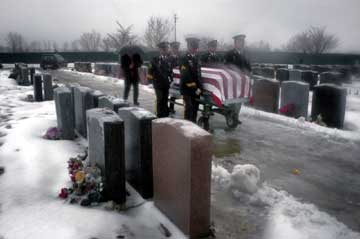
Bronx, NY, 2004, Funeral service for Sgt. Luis Moreno
Paul Fusco began photographing the funerals of American soldiers killed in Iraq in 2004 as a “personal protest against government attempts to downplay the costs of war.” It’s not the emotional force of his images that is startling–that’s to be expected, after all–it’s the embarassment and anger that rises up we realize we’ve hardly seen scenes like this at all in the last three years.
It would be easy enough to point fingers at the administration which has actively thwarted coverage of the war’s toll–on both US and Iraqi lives–through a mixture of censorship, dissembling, misinformation, and stonewalled silence.
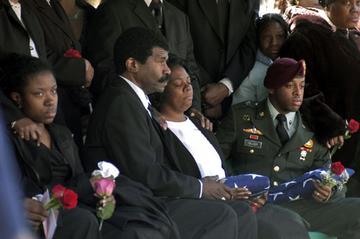
Bridgeport, CT, 2004, Funeral Service for Spc Tyanna Avery
But Fusco’s images prove that these victims of the war’s violence–the soldiers’ families and communities left behind–could be found and reported, if only editors and prodcuers in the news media had the will, and weren’t so occupied with passing along the more easily obtained, press-release and photo-op-driven stories the government so thoughtfully provides.
Senior leaders in the Defense Department and the White House don’t attend solderis’ funerals out a stated wish not to intrude on the family members’ privacy. Apparently, if the President were to attend, there might be journalists and cameras following along.
Paul Fusco’s exhibition, “Bitter Fruit,” is organized by Magnum Photos and is currently at the Aldrich Contemporary Art Museum through February 2007 [aldrichart.org]
Paul Fusco, “Bitter Fruit,” 46 Pictures [magnumphotos.com]
Bush Campaigns Cruises For NASCAR Daddies?
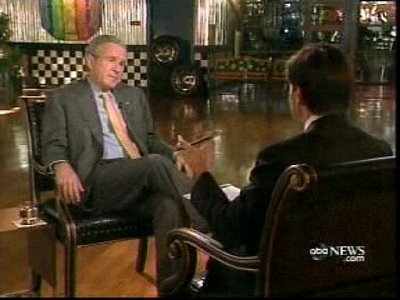
If liberal bloggers start seeing The Gay Conspiracy everywhere, too, does that count as progress?
Because that’s the prevailing interpretation on Americablog for the Sforzian Backdrop of this Stephanopoulos-Bush interview [hot George-on-George action?]. That rainbow flag-looking thing hovering over Bush’s head is probably not a subliminal Big Tent signal to Gannon Republicans, though; considering the interview took place at Victory Junction, Kyle Petty’s NASCAR-themed camp for terminally ill conservative children.
It’s the hood of a rainbow-striped car, a trophy which was seized after all the other drivers formed a mob to run the flamboyantly homosexual driver Jeff Gordon out of town. Next on the list: Jimmy Dean’s sausage [sic].
[an even better explanation, and not just because it might actually be true: it’s a rainbow flag with the word pace on it, which is just like pace cars in NASCAR. What’re the odds? And apparently, it means “peace” in Italian, too, who knew?]
Bush uses gay rights flag as backdrop for ABC interview [americablog via man [heh.]]
Ah, It’s Good To Be The King. Of Uchronia.
Recently returned from abroad and holding court at Interieur 06, a trade show, HSH Arne XV, Emperor of Black Rock City and King of The Uchronians received HM Paola Queen of The Belgians. They presumably traded tales of the quaint customs of the exotic natives in the outer reaches of their respective realms.
And perhaps they talked of their palaces.
The Emperor’s magnificent palace, of course, was burned down, and exists now only on flickr and in a forthcoming promotional book/DVD, produced in a strictly limited edition of 50,000.
For her part, the Queen’s palace features a remarkable work commissioned from artist Jan Fabre, which consists of the shimmering carapaces of over 1.4 million jewel beetles affixed to the ceiling and a chandelier in the Hall of Mirrors.
Previously: Arne Quinze: Branding Man
Standing too close to the fire at Burning Man
uh-on, I hope PS1 doesn’t find out about this
Wow [Make That, “WoW”]: In-Game Photography
We’re beyond Machinima, people. Some titles have photography as part of the gameplay, and some players are tweaking the games themselves to take in-game photographs.
The results are finding their way onto flickr, like Gregory Perez’s homage [top] to Andreas Gursky’s 99 Cent Store [above], which he shot inside “Grand Theft Auto 4: San Andreas”.
Check out the out-of-focus foreground in this shot by Daniel Kuhne from inside SWAT4. Same focal length effect here, too, in Perez’s shot of a plane.
Marco Cadioli “reports from the war online,” covering battles in MMORPG’s. Some of his black & white photos from “Counter Strike” remind me of stills from Pontecorvo’s The Battle of Algiers. He also “works” as an in-game freelance photojournalist named Marco Manray in Second Life.
There’s even a book coming out, Gamescenes: Art In The Age Of Video Games which includes in-game photography and other artistic and journalistic repurposings.
[via wonderland, where a whole bunch of links are accreting in the comments]
If Sforza Ran The CPA…
From very early on, the media’s real problem in Iraq was not covering the success stories even when they were happening right in front of their faces. Take this glowing example from the heady, hopeful days of the Coalition Provisional Authority, where dedicated executive branch appointees worked tirelessly to rebuild Iraq in the White House’s own, Sforzian image:
As the occupation wore on, Senor became the most visible CPA official after Bremer. Clad in a suit, he held televised press briefings several times a week in the Convention Center. The briefing room was decorated by a White House image consultant, who was flown to Baghdad to specify the dimensions and location of the backdrop — a gold seal emblazoned with the words Coalition Provisional Authority. The consultant also had two big-screen plasma televisions affixed to the wall so Senor could play video clips. While other CPA officials waited months for equipment and staff to arrive from the United States, the press room’s needs were quickly met.
that’s an excerpt from former Washington Post Baghdad bureau chief Rajiv Chandrasekaran’s book, Imperial Life in the Emerald City, which kind of makes you yearn for the good old days of 2003. kinda sorta.
Non-Sensical Non-Site Non-Art?: Smithson’s “Hotel Palenque”
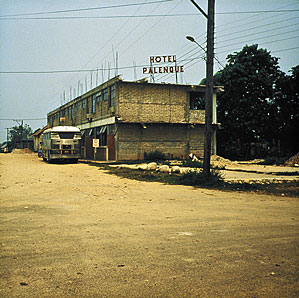
Curator Nancy Spector described Robert Smithson’s Hotel Palenque, which the Guggenheim acquired in 1999 from the artist’s estate [controlled by his widow Nancy Holt and represented by James Cohan Gallery] this way:
Hotel Palenque perfectly embodies the artist’s notion of a “ruin in reverse.” During a trip to Mexico in 1969, he photographed an old, eccentrically constructed hotel, which was undergoing a cycle of simultaneous decay and renovation. Smithson used these images in a lecture presented to architecture students at the University of Utah in 1972, in which he humorously analyzed the centerless, “de-architecturalized” site.
Extant today as a slide installation with a tape recording of the artist’s voice, Hotel Palenque provides a direct view into Smithson’s theoretical approach to the effects of entropy on the cultural landscape.
Smithson’s lecture combines deadpan delivery with absurdist architectural/archeological analysis of a contemporary ruin, a critique–or a spoof–of the kind of academic jargon-laden travelogue usually reserved for slideshows of “real” architecture like the nearby Mayan temple complex.
The lecture is available in several formats: the Guggenheim version was included in the recent MoCA/Whitney retrospective; an illustrated transcript was published in Parkett #43 in 1995; and the incomparable UbuWeb has a 362mb film of the 1972 event for download. [update: uh. ] There was even a “cover version” “performed” by an artist last year in Portland.
But re-viewing the “original” really makes me wonder. The differences between various posthumous incarnations and interpretations of the “Hotel Palenque” lecture seem significant enough to make me question what Smithson actually intended for the lecture, how it was originally received, how it has been contextualized today, and if it is even a “work” at all.
The medium through which art is experienced inevitably influences its perception and interpretation. For an entire generation while it was submerged, the Spiral Jetty “existed”–or was experienced–only through memory, history, text and photo documentation, and, importantly, the artist’s own “making of” film. Once the actual work started re-emerging in 1993-94, its experiential aspects have shifted; now The Visit, the spatial situation, environmental conditions and entropic forces at the site, and the interplay between the Jetty‘s manifestations come to the fore.
Similarly, Palenque is consistently described in hindsight, through the sophisticated conceptual contstruct of Smithson’s writings, but to watch it, Palenque actually sounds like a dorky, rambling joke, more parody than pronouncement. The only real jargon he uses are “situation” [in the architectural sense] and “de-architecturization.” Otherwise, the real/only humor comes from the juxtaposition of his blandly weighty assertions of importance and photos of torn plastic roofing, piles of bricks, and a room propped up by shaky-looking poles [“this is how we approached the site; our car is right there, see between those two columns?”]
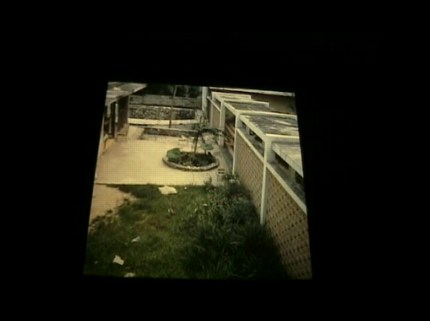
The lecture is described as funny, but the only laughter I could hear sounded nervous, or at least tentative. And without knowing anything of how the lecture came to be, and how it was received and reviewed at the time, I can’t help but imagine that some people, like Smithson’s hosts, or his audience, might have felt like the butt of some smart-alecky New York artist’s practical joke. Overall, I guess I find it hard to reconcile Smithson’s sophomoric performance with his hallowed reputation; the lecture fits more neatly with his early, critically challenging “high school notebook doodle” drawings of busty angels than it does with his heavily theoretical Artforum articles.
[It’s worth pointing out that Smithson’s photo/slides, on the other hand, feel very resolved and coherent. I was repeatedly reminded of Gabriel Orozco’s photos of “found” sculptural scenarios and moments, as well as of Smithson’s own Passaic series and other photographs. We have a favorite photo, a top-down shot of a pile of bricks, that he did after returning from the Yucatan; the man does have a way with rubble.]
But the most problematic issue about Palenque could be a non-issue for almost any conceptual artist, but it seems paramount given Smithson’s own ideological concerns with the gallery/museum space and system: to what extent should the lecture be considered “performance” or a “work of art” itself? The Guggenheim’s version of Hotel Palenque consists of a slideshow and an audiotape, which plays in polite form in a museum gallery.
But before/besides that incarnation, the lecture “existed” [or was experienced] as a filmed version, made with a handheld camera seated somewhere in the crowd in Salt Lake City. Smithson himself is off camera, and several times, the slides themselves are, too. The film is a bootleg only to the extent Baltimore artist Jon Routson‘s self-consciously askew video recordings of movies are, which is to say, “not at all.” The amateurish, sometimes forgetful framing and the handheld jitters heighten the experiential, audience perspective. There’s one passage where the camera bobs up and down in synch with its operator’s breathing. These are all central, even overwhelming, elements of the Palenque film, and they’re utterly absent from the “institutionalized” version, just as Smithson’s delivery is lost in the Parkett transcript [a version which no one would mistake for anything but documentation or reportage.] It’s enough to make me wonder just what the Guggenheim bought–or just what the Smithson estate sold–with Hotel Palenque which, by 1999, had to be one of the few significant “pieces” or, less problematically, holdings, left in the estate.
The Guggenheim also bought, at the same time, nine slides of Yucatan Mirror Displacements, iconic images of landscape interventions which Smithson made on the same 1969 trip. But these slides–which illustrated an Artforum essay and are widely reproduced in print–have never existed to my knowledge in artist-sanctioned formats like traditionally editioned prints. I’d be very interested to see documentation or scholarship on this question–which is also a fancy way of saying I have no idea or direct knowledge at this point–to see just how closely Smithson’s definition of defined, purchasable work jibes with notions operative in 1999 among art dealers and museum acquisition committees.
Because there have already been plenty of cases where Smithson’s ideas, his works, and his estate’s interpretations of them sometimes seem out of synch. Had Smithson not died suddenly and tragically the next year would this offhand-seeming ramble be treated with even a fraction of the reverence it has received? And if there had been more sculptures and clearly identifiable “work” to sell in the estate when Smithson’s star re-emerged in the late 1990’s, would Hotel Palenque ever have made it out of the archives and into a major museum’s collection?
Previously: UT gov’t decides to clean up the Jetty site
Nancy Holt floats the idea of “restoring” the Jetty
“The Spiral Doily”: What if sprawl is the real entropy?
Other Smithson-related posts on greg.org
Elsewhere: Brian Dillon’s appreciation of the lecture as artform in Frieze

